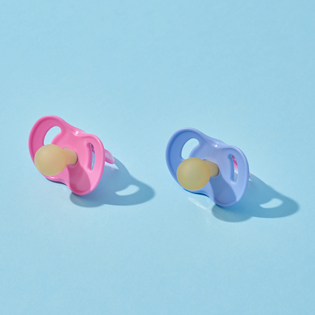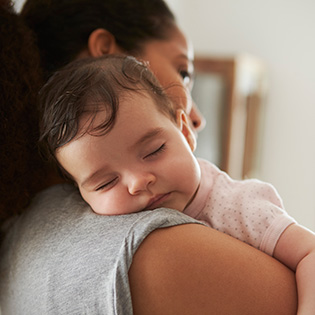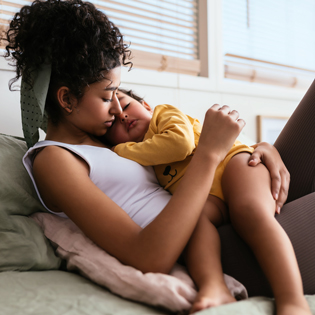Just so you know, What to Expect may earn commissions from the links included on this page. All sales and prices are accurate at the time of publishing.
Once you find out you're expecting, the excitement starts to build, as does the anticipation of answering so many unknowns, including your baby's sex. As many as 70% of parents now choose to learn their baby's sex during pregnancy instead of waiting until birth.[1]
The big reveal isn't just happening at the doctor's office. Recently, a number of new "at-home gender tests" have moms-to-be collecting a blood or urine sample at home and sending it to a lab for analysis; these companies claim they can reveal the sex of an unborn baby as soon as six weeks into the pregnancy without you stepping foot into a doctor's office.
While at-home gender tests may sound like an easier and more affordable alternative to the lab work that many OB/GYN practices provide, do they truly deliver on their promises? Not quite, says Janet Choi, M.D., a double-board certified reproductive endocrinologist and OB/GYN.
Let's delve into the world of at-home gender tests, exploring their accuracy, reliability and the science behind them.
What are at-home gender tests?
At-home gender tests are over-the-counter products available online and at drugstores. They claim to predict the sex of your unborn baby before the traditional anatomy scan (which typically happens between 18 and 20 weeks of pregnancy).
These tests work by looking for fetal DNA markers in a sample of the mother's blood or urine. The presence of Y sex chromosomes suggest a baby boy is on the way; otherwise, the test predicts you'll have a baby girl.
Note that while these tests are marketed as "gender tests," what they're really assessing is biological sex; gender is a person's self-representation, and it's different from sex.[2]
Read Next
Are at-home gender tests the same as professional medical tests?
While these kits aim to answer the boy-girl question, it's essential to understand what they actually measure — and how this differs from the professional tests your doctor would perform.
The kits claim they're up to 99% accurate, but it isn't clear how these findings are validated, explains Janet Choi, M.D., double-board certified reproductive endocrinologist and OB/GYN.
The non-invasive prenatal testing (NIPT) performed in your doctor's office is different in a number of ways, Dr. Choi says. NIPT:
- Typically uses a larger sample size (about 10 milliliters of blood — more than just a drop)
- Is analyzed by a certified, trusted lab
- Also looks for Down syndrome, Trisomy 18, Trisomy 13 and other chromosomal abnormalities, including sex chromosome disorders.
- Happens later (after 9 weeks gestational age, versus some kits which offer detection as early as 6 weeks)
If you don't get NIPT during your first trimester, your provider can typically determine your baby's sex at your 20-week ultrasound, also called the anatomy scan. This test primarily assesses fetal development, including genitalia and other organs.
Are at-home gender tests accurate?
The accuracy of at-home gender tests can vary. Some manufacturers claim their tests work extremely well, touting accuracy rates that exceed 90%. However, there are a number of ways the test could show you the wrong results, Dr. Choi says:
- You recently received a blood transfusion or stem cell transplant. (Usually, a small amount of the donor's DNA stays in your system for a few days.[3] If the donor was male, the test may incorrectly predict a baby boy.)
- DNA from a male partner or another household member contaminates the sample.
- The quality of the sample isn't very good, or the test is taken too early on in pregnancy.
- You're expecting twins or multiples.
- A sex chromosome disorder (not having a clear pair of XY or XX chromosomes) affects the test.
For this reason, approach these tests with a degree of skepticism and an understanding that they're not foolproof, Dr. Choi advises.
If you're tempted to use a different DIY method, remember that many other methods of gender prediction (such as the ring test, baking soda method or Chinese gender chart) have no scientific basis and are highly unreliable — but they're harmless and can still be fun if you want to try one.
What are the most popular at-home gender tests?
Even though it might not work, it can still be exciting to try an at-home gender test. Here are a few of the most popular at-home gender tests to consider.
SneakPeek Early Gender DNA Test Kit
The SneakPeek Early Gender DNA Test Kit claims to reveal a baby's sex as early as 6 weeks into pregnancy, which is not too long after many people find out they're expecting.
The test kit comes with everything needed to collect a tiny sample of your blood via finger prick. You send the sample to their lab, where it undergoes DNA analysis to detect the presence — or lack thereof — of male (Y) chromosomes. With SneakPeek's standard service, you can expect to receive results five to seven days after the sample reaches their lab. Alternatively, you can pay another $70 for an even faster analysis.
Standard kit cost: approximately $79
FastTrack kit cost: approximately $149
Claimed accuracy: more than 99% when done at 6 weeks of pregnancy or later
Peekaboo Early Gender DNA Test
This gender prediction kit works similarly to SneakPeek's in that it uses a maternal blood sample to predict your baby's sex. You can try the test kit as early as 7 weeks into pregnancy. Using the provided finger prick device, you collect a small blood sample and then mail to their lab in a prepaid envelope.
The lab analyzes the sample for the presence of Y chromosomes, which would indicate a boy. If no Y chromosomes are detected, the test assumes the baby is a girl. Expect results within one to two business days after the lab receives the sample.
Cost: $65
Claimed accuracy: 99.5% (and a money-back guarantee if the prediction is incorrect)
IntelliGender Gender Prediction Kit
If the idea of collecting your own blood at home makes you squeamish, here's an alternative. The IntelliGender Gender Prediction Kit purports to predict the gender of an unborn baby using a urine sample.
Simply pee into the provided cup first thing in the morning. Mix in the chemicals the kit provides, and watch the color change after a few minutes. According to the company, a green color suggests a boy, while an orange color suggests a girl. You need to perform this test later than 10 weeks into pregnancy, but the results are available within minutes.
Cost: $30
Claimed accuracy: about 82%, based on user feedback and their own testing
GENDERmaker Gender Predictor Test Kit
Here's another at-home gender test that uses urine instead of blood — and you can try it as early as 6 weeks into pregnancy. Collect a first-morning urine sample, let it cool to room temperature and then use a dropper to place a few drops on the test window — very similarly to how you'd use a pregnancy test or COVID test.
The ensuing chemical reaction predicts the baby's sex within minutes, changing to pink for a girl or blue for a boy. A color chart is included to help interpret the results accurately.
Cost: $20
Claimed accuracy: none listed, but there's a "positive feedback rate" of 98.4%
GenderBliss Gender Predictor Kit
This at-home gender prediction kit also uses a urine sample to determine your baby's sex.
Collect a sample of your urine — ideally the first-morning pee. Then use the provided syringe to collect 2.5 milliliters of urine and drop it into the window well of the test. Within minutes, results will appear: red for a girl or blue for a boy. You can try the GenderBliss test as early as 8 weeks into pregnancy.
Cost: $13.50
Claimed accuracy: none listed, and GenderBliss notes that their product is not for people who are looking for a 100% accurate result
The bottom line
While at-home gender tests can be a fun and exciting way to potentially learn your baby's sex, it's important to approach them with realistic expectations. These tests are not as accurate as professional medical methods, and they shouldn't replace regular prenatal care.
If you really want to find out your baby's sex during pregnancy, talk to your doctor or midwife about your options.












































 Trending On What to Expect
Trending On What to Expect





